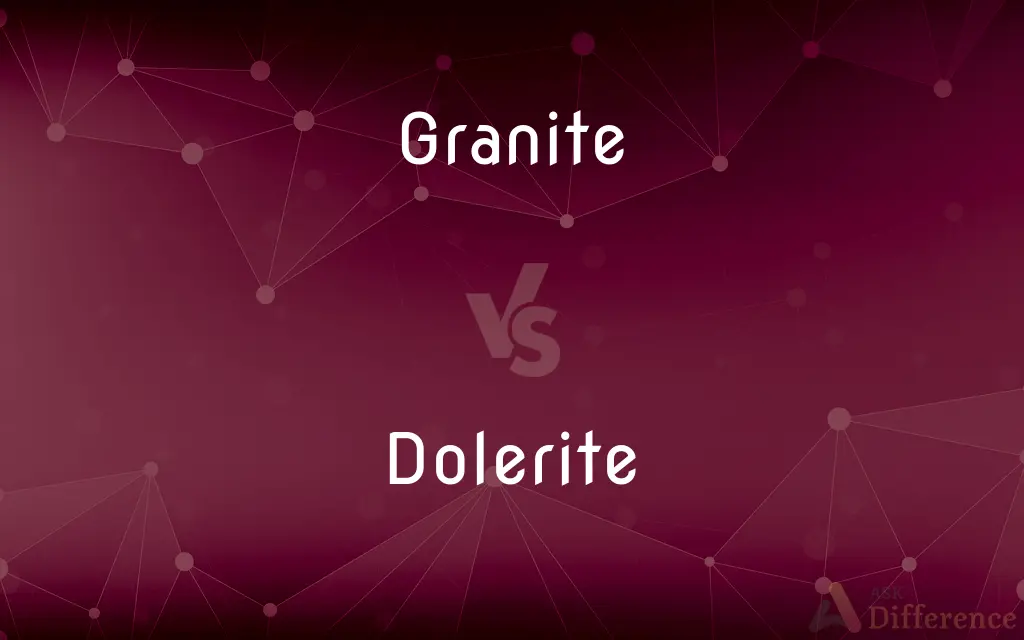Granite vs. Dolerite — What's the Difference?
By Maham Liaqat & Fiza Rafique — Updated on March 29, 2024
Granite is an intrusive igneous rock, known for its coarse grain, while dolerite is a medium-grained, intrusive igneous rock, often referred to as diabase.

Difference Between Granite and Dolerite
Table of Contents
ADVERTISEMENT
Key Differences
Granite is a widely known and utilized igneous rock, characterized by its coarse-grained texture. This texture results from the slow cooling of magma deep within the Earth's crust, which allows large crystals of minerals like quartz, feldspar, and mica to form. Granite is admired for its durability and aesthetic appeal, making it a popular choice for countertops, monuments, and building facades. On the other hand, dolerite, also known as diabase, has a medium-grained texture and forms when magma cools more quickly than granite but not as rapidly as basalt. This results in smaller, yet visible crystals primarily composed of plagioclase feldspar and pyroxene.
In terms of composition, granite is rich in silica, which gives it a lighter color range, from white to pink, and sometimes even gray. Its high quartz content is a defining feature, contributing to its hardness and resistance to weathering. Dolerite, while also an intrusive igneous rock, has a composition that is typically richer in iron and magnesium, giving it a darker color, usually gray or black. This difference in mineral composition influences not only the rock's appearance but also its physical properties and uses.
One of the most distinct differences between granite and dolerite is their formation environment and cooling history. Granite forms deep within the Earth’s crust, where magma cools slowly over thousands to millions of years, allowing large crystals to develop. Dolerite, in contrast, is often associated with shallow intrusions or as dikes and sills that intrude into other rock types. Its cooling is faster than granite's but slower than that of extrusive rocks, leading to its medium-grained texture.
In terms of usage, granite's aesthetic and durable properties make it a favored material in construction and decorative applications. Its resistance to abrasion and weathering allows it to be used in high-traffic areas, as well as in outdoor monuments and as a dimension stone. Dolerite, with its harder, denser nature and resistance to weathering, is often used in road construction, as crushed stone for aggregate, and sometimes in building construction, though its applications are generally more utilitarian compared to granite’s more decorative uses.
While both granite and dolerite serve important roles in both natural landscapes and human applications, their differences in texture, composition, formation, and use highlight the diversity of igneous rocks and their significance to geological and commercial practices.
ADVERTISEMENT
Comparison Chart
Texture
Coarse-grained
Medium-grained
Composition
High in silica, quartz, feldspar, mica
Richer in iron and magnesium, plagioclase feldspar, pyroxene
Color
White, pink, gray
Usually gray or black
Formation
Deep within the Earth's crust
Shallow intrusions, dikes, sills
Cooling Time
Slow (thousands to millions of years)
Faster than granite, slower than basalt
Uses
Construction, monuments, decorative items
Road construction, aggregate, utilitarian uses
Compare with Definitions
Granite
Coarse-grained igneous rock.
The granite countertop added elegance to the kitchen.
Dolerite
Richer in iron and magnesium.
Dolerite's dark color comes from its iron-rich composition.
Granite
Rich in silica and quartz.
Granite's durability is due to its high quartz content.
Dolerite
Medium-grained igneous rock.
The dolerite dyke cut through the surrounding rock.
Granite
Popular for construction and decorative uses.
The monument was crafted from a single block of granite.
Dolerite
Forms in shallow intrusions.
The dolerite sill formed when magma intruded between rock layers.
Granite
Slow cooling deep in the crust.
The large crystals in granite indicate its slow cooling process.
Dolerite
Used in road construction and as aggregate.
Crushed dolerite was used as a base for the highway.
Granite
Resistant to weathering.
Granite's resistance to weathering makes it ideal for outdoor use.
Dolerite
Denser and harder than granite.
Dolerite's density makes it an excellent choice for heavy-duty applications.
Granite
Granite () is a coarse-grained igneous rock composed mostly of quartz, alkali feldspar, and plagioclase. It forms from magma with a high content of silica and alkali metal oxides that slowly cools and solidifies underground.
Dolerite
A dark, fine-grained igneous rock; diabase.
Granite
A common, coarse-grained, light-colored, hard igneous rock consisting chiefly of quartz, orthoclase or microcline, and mica, used in monuments and for building.
Dolerite
(geology) A type of fine-grained basaltic rock.
Granite
Unyielding endurance; steadfastness
A will of granite.
Dolerite
A dark, crystalline, igneous rock, chiefly pyroxene with labradorite.
Granite
(rock) A group of igneous and plutonic rocks composed primarily of feldspar and quartz. Usually contains one or more dark minerals, which may be mica, pyroxene, or amphibole. Granite is quarried for building stone, road gravel, decorative stone, and tombstones. Common colors are gray, white, pink, and yellow-brown.
Granite
Toughness; the quality of having a thick skin or being rough.
Granite
A crystalline, granular rock, consisting of quartz, feldspar, and mica, and usually of a whitish, grayish, or flesh-red color. It differs from gneiss in not having the mica in planes, and therefore in being destitute of a schistose structure.
Granite
Plutonic igneous rock having visibly crystalline texture; generally composed of feldspar and mica and quartz
Granite
Something having the quality of granite (unyielding firmness);
A man of granite
Common Curiosities
What is granite?
Granite is a coarse-grained igneous rock formed from slow-cooling magma deep within the Earth’s crust.
What is dolerite?
Dolerite, or diabase, is a medium-grained igneous rock that forms from magma cooling more quickly than granite but slower than basalt.
How do granite and dolerite differ in composition?
Granite is rich in silica and quartz, making it lighter in color, whereas dolerite is richer in iron and magnesium, giving it a darker appearance.
Can dolerite be used decoratively like granite?
While dolerite is mainly used for utilitarian purposes like road construction and aggregate, its applications are generally less decorative than granite’s.
Is dolerite harder than granite?
Dolerite is generally denser and harder, making it suitable for heavy-duty applications, although granite is also very durable.
What are the primary uses of granite?
Granite is widely used in construction, for monuments, and decorative items due to its durability and aesthetic appeal.
Are there environmental considerations for using granite and dolerite?
Yes, quarrying and mining activities can have environmental impacts, but responsible practices can mitigate these effects.
How does the cooling process affect the texture of granite and dolerite?
The slow cooling of granite deep in the Earth allows large crystals to form, resulting in a coarse-grained texture, while dolerite’s faster cooling results in a medium-grained texture.
Why is granite preferred for outdoor monuments?
Its resistance to weathering and abrasion makes granite ideal for outdoor use, maintaining its appearance over time.
Where is dolerite typically found?
Dolerite is often found in shallow intrusions, such as dikes and sills, where magma has cooled more rapidly.
How does the color of granite and dolerite differ?
Granite ranges from white to pink to gray, reflecting its silica and quartz content, while dolerite is usually gray or black due to its iron and magnesium content.
How are granite and dolerite extracted?
Both rocks are quarried, with granite often cut into large blocks and dolerite typically crushed for use as aggregate.
Can the composition of granite and dolerite affect their usage?
Yes, the composition affects both appearance and physical properties, influencing their suitability for different applications.
Share Your Discovery

Previous Comparison
Telecom vs. Datacom
Next Comparison
Amplifier vs. RepeaterAuthor Spotlight
Written by
Maham LiaqatCo-written by
Fiza RafiqueFiza Rafique is a skilled content writer at AskDifference.com, where she meticulously refines and enhances written pieces. Drawing from her vast editorial expertise, Fiza ensures clarity, accuracy, and precision in every article. Passionate about language, she continually seeks to elevate the quality of content for readers worldwide.
















































